 Game: Gears of War: Judgement
Game: Gears of War: Judgement
Developer: People Can Fly, Epic Games
Publisher: Microsoft Studios
Available on: Xbox 360 only
Gears of War may not be the flagship Xbox 360 franchise – with that honour clearly going to the Halo series – but it has become synonymous with the Microsoft gaming console nonetheless. And, whereas the Halo series has seen six games released on the 360, and Call of Duty has reached a whopping eight titles – what with its yearly updates – the Gears of War series has been a more patient affair, and more time has passed between each individual entry.
That is why fans reacted with a small measure of surprise when a new fourth game was announced at E3 last year, little more than six months on from the release of Gears of War 3. But there would be two major differences for this title: first of all, the game would be developed by People Can Fly (the Epic offshoot studio who developed Bulletstorm) and secondly, the game would be a prequel to the main trilogy, set at the start of the war between the COG and the Locust army. Can Judgment match up to the main series, or will it go down as merely a failed attempt to re-invigorate the franchise?
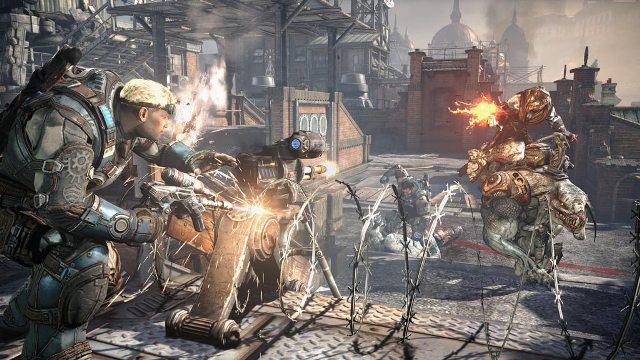
STORY: The latest entry is set shortly after E-Day (or Emergence Day), the fateful day on which the Locust army rose up from the catacombs beneath the planet Sera to wage war on the human population above. Taking place in Halvo Bay, an affluent city on Sera where the Onyx Guard training academy is based, Judgment sees us taking on the role of Kilo Squad – which is made up of some familiar and some not-so-familiar faces, lead by Damon Baird, the wise-cracking Lieutenant, and also featuring a very young-looking Augustus Cole. Making their return after being a major part of the original trilogy, they are joined by two new squad-mates: Sofia Hendrik, a trainee Onyx Guard cadet, and Garron Paduk – a soldier who opposed the COG in the Pendulum Wars, but who has joined forces with them after his home of Gorasnaya was decimated by the Locust.
The game begins with these four being held prisoner and put on trial by Colonel Loomis – an old-fashioned military leader who has a major problem with how Baird conducts himself in the war on the Locust. We take on the role of the four characters as each of them gives their testimony to the court, in flashback sequences of how they fought General Karn – a powerful Kantus – as he tried to destroy Halvo Bay. This is quite a good story-telling technique, as it allows for the testimony of the characters to form a kind of narration that accompanies the in-game action, explaining and clarifying more of the back-story as we go along. This results in what feels like a much tighter and more focused narrative than we have seen in the past titles, with more exposition to let us know what is really going on. Of course, there are also plenty of references to events and aspects of the later games, and these will no doubt be of great interest to fans of the series, helping to flesh out the events of the start of the war like never before.
GRAPHICS: Visually, Judgment won’t blow players away as it is predictably similar to Gears of War 3. The same engine has been employed here and the game certainly has the Gears of War look down pat, regardless of the change in developer. Judgment has been tweaked and improved a little here and there, though, and it doesn’t seem to suffer from the pop-in of character and environment details that has afflicted past entries. Also, the game seems to show off what seems like greater draw distances than ever before, and perhaps even more detailed backdrops than we have been used to – but that might be down to the fact that the majority of the levels are set outside, are bigger in scope, and in daylight – making the game look more lush and attractive overall, despite the wartime violence and chaos. Being set in a wealthy district has allowed for the team to build some impressive and beautiful architecture – and then smash it up a bit before our eyes, making for a more visually-engaging game than ever before.
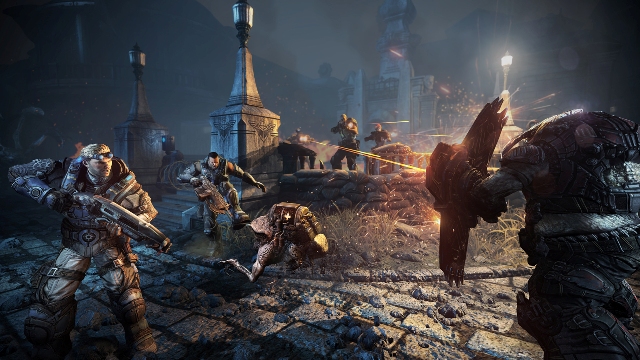
SOUND: This Gears title once again sounds suitably epic and engaging, with a great cast producing some truly convincing voice-over work. The sound effects are suitably meaty, with guns sounding as satisfying as you would like, and the growls and grunts of your enemies all the more disturbing. The soundtrack re-uses many recognisable themes and cues from the previous games, but also adds some heavier music and more guitar-driven tracks, mixed in with the orchestral film-like score, to emphasise the intense action taking place. The music does change accordingly to suit the mood of the story, and all the the aspects of the sound design tie together very well to create a great sonic experience.
GAMEPLAY: Like the visual side of the title, the gameplay hasn’t changed hugely since Gears of War 3 – but there are many notable changes and additions that actually make Judgement stand out quite clearly as a different playing experience from your regular Gears of War games. The action is split across several larger levels, which are each divided into around eight or so mini-sections. In each of these smaller sections players can try to earn stars – between zero and three – depending on how well they complete the area. Mixing up your kill methods, performing executions and not getting downed will all help raise your score, and you can re-play these sections in order to try to improve. This will make you approach levels a bit more strategically, and perhaps with a little more caution. Be over-cautious though, and you won’t earn enough stars either.
To add to this, each sub-section will feature a Red Omen on the wall, and if players interact with this they can choose to accept or decline a de-classification mission. This involves Kilo Squad revealing a new fact about that section in their trial, which will affect how the mission is played out. For example, Baird may reveal that they took out a horde of Locust using only shotguns, and if you accept the task, you can only use your Gnashers or Sawn-Offs – or perhaps the Wretches in the level will be replaced by exploding Lambent wretches instead. The reward for doing these side missions is an increase in the speed at which you earn stars, making the game more difficult in the process. This means you can customise how you play each level, and how much of a challenge you set yourself.
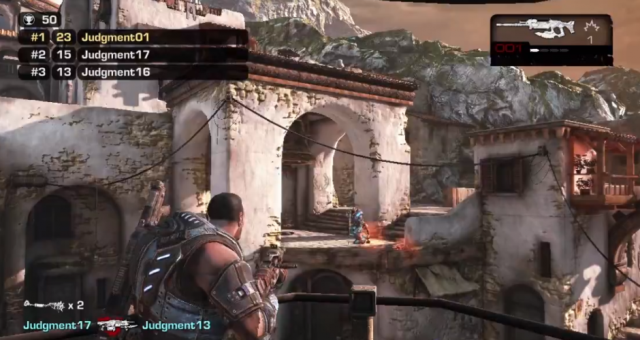
The enemies in Judgement also act differently than ever before. Due to a new “Smart Spawn” feature, no longer will levels play out in exactly the same way every time that you play. Now, enemies can and will spawn at slightly different locations on the map, keeping you on your toes and making it that little bit harder to learn a map and figure out how to easily beat it. Not only does the location of the enemies change, but the class will also differ across various attempts. For instance, you may encounter Grinders on one play-through of a section, but then upon re-loading the checkpoint these Grinders may have been replaced by Maulers. This all makes the game seem a lot fresher and adds more variety to each play-through.
Other, smaller changes have been made, such as the addition of several new guns and enemies into the mix. We get to use many of the weapons that Paduk used in Gorasnaya, such as the Booshka (a bouncing grenade launcher), the Tripwire Crossbow that sets up explosive traps for enemies, and the Breechshot – a scope-less sniper rifle that acts more like a high-powered shotgun. To counteract these new add-ons to your arsenal, there are a few new classes of Locust to contend with, such as the Rager, who looks like a regular grunt, but upon getting angry “hulks up” into a spiky, charging beast. The way you select weapons has even been altered slightly, so the sometimes slow D-Pad selection has been removed, and now as well as aiming grenades you can simply tap a bumper button to allow a quick-throw – a nice feature that has been a long time coming. It takes some getting used to, but works well once you acclimatise to it. These little additions really give the game a new feel, and help it stand out from the previous entries rather than just appearing as a glorified expansion.
MULTIPLAYER: The changes certainly aren’t limited to the campaign, which can also be played by up to four players in co-op: the multiplayer has also been altered quite heavily to produce a very different overall result. Aside from featuring the traditional team deathmatch, which is the bread and butter of Gears of War multiplayer, the game modes have been almost entirely overhauled, with quite a few new options added.

Firstly, we have free-for-all – a first for the series where players go all out in an every man for himself type affair with no Locust in sight. Everyone controls a different COG soldier and we get a very even playing field in order to allow gamers to see who can come out on top. Domination is another new addition, in which two teams of COG go against one another, trying to capture three control points. Wait around in the area in question, and you can turn it to your team colour – the longer your team holds on to more of the control points, the faster your score will increase, with the winning team being the first to reach a pre-set score target. These three modes add quite a variety of play options for gamers on their own, but the addition of two other modes changes the way the game is played even more.
These are Overrun and Survival – one being a versus mode, and the other a co-operative mode against computer-controlled bots. The two are very similar, being more or less the same mode, tweaked a little. In Overrun, the game sees the COG team trying to defend two sealed Emergence holes and a Hammer of Dawn beacon, whilst the Locust team is trying to destroy all three. This in effect acts as three waves, where once one Emergence hole is opened up, we move to the next hole, and so on – until either all of the COG bases have been destroyed, or until all the Locust have been held off and destroyed by the Hammer of Dawn.
What makes the mode interesting however, is that – in another first for the series – players choose a different class to play as when they play as the COGs. They can be a Medic, who carries healing Stim-Grenades; the Soldier, who can dispatch ammunition crate grenades for the team to re-fill their weapons; the Scout, equipped with a new Marzka sniper rifle and spotting grenades so that teammates can see the enemies coming; or an Engineer, who can deploy auto-turrets and also repair defensive fortifications.
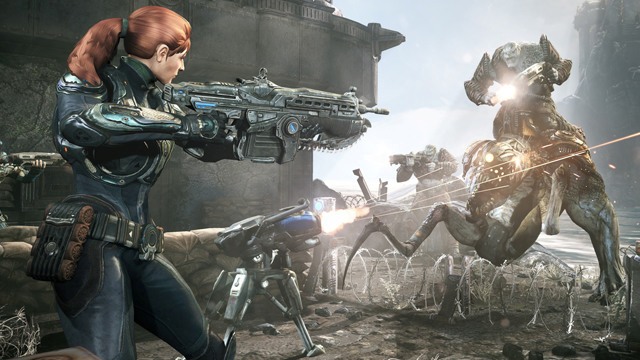
This makes it all play out a lot more like games such as Team Fortress 2, and teams will have to work together and make the most of their different skills carefully in order to successfully survive. Locust players can choose from a selection of different Locust troops, who possess similar skill-sets such as the healing Kantus and the fortification-destroying Ticker. In both Overrun and Survival, down-but-not-out features in a new way, whereby Medics must heal their teammates. There was some uproar when this was announced, but it makes sense when you look at the new class-based multiplayer modes, and its absence from free-for-all is obvious, as that is purely a competitive mode.
What differs between the versus game of Overrun and Survival is that you can only play as the COG in Survival, and players can team up in order to take on ten waves of Locust enemies. In that sense, it is a strange combination of Overrun and the Horde mode seen in previous games, and players must co-operate in order to defeat increasingly difficult waves of Locust opposition. But rather than simply losing if the Locust destroy your base, you still have the three bases and – in theory – three lives that you have in Overrun mode. These two modes may not differ greatly, but it is interesting to see the class-based features of Overrun coupled with the sensibilities of surviving ever-decreasing odds from Horde – this is probably the multiplayer mode that has the most legs in the long run.
LONGEVITY: And that leads directly into the fact that there are plenty of features on offer in Judgement that provide the opportunity to extend your gameplay experience and to add some real longevity to proceedings. Firstly, in the story-based campaign, the aspects of earning stars for performing more efficiently in missions, and the option of making things harder for yourself by either accepting or declining the de-classification missions, both add some re-play value to the regular campaign – making the player feel that they can actually get quite a different experience by choosing to play each stage in slightly varying ways. Add Smart Spawn into the mix, and there is the potential that one play-through could differ quite wildly from the next.
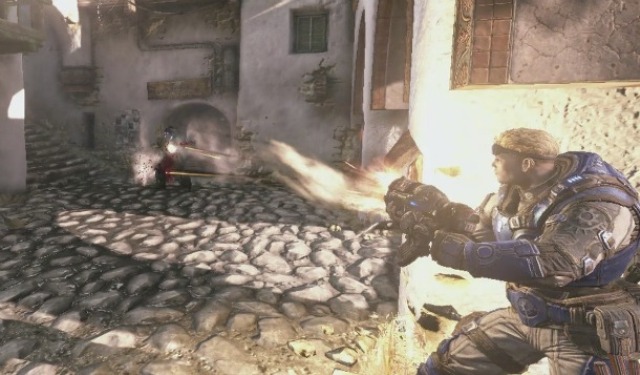
Then you have the new additions to multiplayer, which are bound to keep fans both old and new entertained for many extra hours. An increased emphasis on co-operative multiplayer modes in the last few Gears of War games has meant that even gamers who don’t like playing competitively over Xbox LIVE can still extend the life of their game by teaming up with friends against the AI, but now there are even a few new options for the competitive players out there too – who I imagine will snap up the opportunity for some all-against-all action. And then when you add the class specification modes into the mix too, players can choose how they want to play in multiplayer, and have four different techniques to master. You barely even need to mention that Achievements, levelling up and collecting COG Tags all help add to the lifespan of this game – it already has so much going for it.
VERDICT: What initially sounded like a quick cash-in on a beloved series has in fact proved to be a quite revolution for Gears of War. The fundamentals may all be more or less the same as they have ever been, but so many of the new and different design choices and gameplay mechanics that have been implemented have really allowed developers People Can Fly to put their own mark on the game.
Setting Judgment in the past has allowed the team to experiment with an engaging new story-telling technique, and to give players some interesting choices that allow them to play the game the way they want to play it – resulting in a game that feels more unique to the individual. They may have made a few changes, which some gamers might not entirely appreciate, but a lot of these changes seem like a natural evolution rather than a forced one. Thankfully this doesn’t feel at all like a game that has been farmed out to a third-party developer, but rather an integral part of the Gears of War canon.







